2017 HCHB_digital
Create successful ePaper yourself
Turn your PDF publications into a flip-book with our unique Google optimized e-Paper software.
Sun Care: Eye Protection<br />
Protecting eyes against the sun is just as important as protecting skin. While most<br />
people are aware of the link between ultraviolet (UV) radiation and skin cancer<br />
(see also Sun Care), few realise the connection between UV radiation (UVR)<br />
exposure and eye damage.<br />
Particles in the atmosphere scatter UVR so even staying out of direct sunlight<br />
does not eliminate this hazard. UV damage to the surface tissues and internal<br />
structures of the eye (such as the cornea and lens) can occur from either natural<br />
sunlight or artificial UV rays.<br />
In the short term, excessive exposure to UV radiation from daily activities can burn<br />
the surface of the eye, similar to a sunburn on the skin. Exposure is exacerbated by<br />
reflections off snow, concrete, water, or other shiny or white surfaces.<br />
Acute effects<br />
Acute effects of UV radiation on the eye include inflammation of the cornea and<br />
the iris, photoconjunctivitis (an inflammation of the conjunctiva, the membrane<br />
that lines the inside of the eyelids), and photokeratitis (snow blindness: a<br />
temporary but painful burn to the cornea).<br />
Long term risks<br />
Long-term exposure to UV radiation can lead to, or increase the risk of:<br />
• age-related macular degeneration: a deterioration in macular tissue that<br />
causes loss of central vision<br />
• cataracts: a clouding of the eye’s lens that can blur vision<br />
• pterygiums: a white or creamy opaque growth attached to the cornea (white<br />
of the eye). These are usually non-cancerous, but may grow over the cornea,<br />
partially blocking vision, and may require surgery to be removed<br />
• skin cancer around the eyelids: basal cell carcinoma is the most common.<br />
In order to reduce the risk of eye damage, sunglasses should always be worn<br />
outside, particularly when it's sunny, at the beach or near water, when driving or<br />
outside at high elevations or participating in snow sports. Anybody with an eye<br />
disease, who has had cataract surgery, or is taking photosensitising medicines<br />
should always wear sunglasses outside.<br />
Choosing sunglasses<br />
While more expensive sunglasses may use slightly dearer materials for both the<br />
frame and the lens, sunglass cost has more to do with the brand name than a<br />
reflection of UVR protection. Pharmacies should choose to only stock sunglasses<br />
that comply with the Australian/NZ standard (AS/NZS)1067:2003, or another<br />
internationally recognised standard. Note that this standard is only voluntary in<br />
New Zealand, although it is mandatory in Australia.<br />
Initial assessment<br />
Help customers select sunglasses that best suit the main activity for which they<br />
will be worn. For example, polarised sunglasses are best for fishing and driving;<br />
nylon blended frames are resistant to hot and cold, and easily moulded into<br />
wrap-around styles so are ideal for high-intensity sports; and purple or rose tints<br />
offer the best contrast of objects against a green or blue background so are<br />
perfect for hunting or water-skiing. Importantly, the customer likes and feels<br />
comfortable in the sunglasses, which makes them more likely to be worn.<br />
People who wear corrective lenses may consider having a UV protective coating<br />
added to their prescription lenses, investing in a pair of prescription sunglasses or<br />
buying protective shades that can be worn over their vision-correcting glasses.<br />
About the Australian/NZ standards (AS/NZS)<br />
The AS/NZS: 1067:2003 sets limits on the allowed transmittances of fashion<br />
spectacles and sunglasses for adults and children. Sunglasses that are allowed to<br />
be worn while driving must comply with the colouration limits of AS/NZS 1067.<br />
Colours, in particular traffic signals, must still be recognisable when viewed<br />
through the lenses. The standard defines five categories of lenses – see below.<br />
LENS<br />
DESCRIPTION<br />
CATEGORY<br />
0 Fashion spectacles with very low sunglare<br />
reduction. Some UVR protection<br />
1 Fashion spectacles – not sunglasses. Limited<br />
sunglare reduction. Some UVR protection<br />
2 Sunglasses – medium sunglare reduction<br />
and good UV protection<br />
3 Sunglasses – high sunglare reduction and<br />
good UV protection<br />
4 Special purpose sunglasses – very high<br />
sunglare reduction. Good UV protection<br />
ADDITIONAL<br />
ENDORSEMENTS<br />
None<br />
Not suitable for<br />
driving at night<br />
None<br />
None<br />
Must not be used<br />
when driving<br />
Several other markings may be found on sunglasses including the Eye<br />
Protection Factor (EPF) rating. This takes into account the frame coverage, UV<br />
protection, blue light and infrared protection (ability to shield the eyes from<br />
heat). Sunglasses labelled EPF 10 actually exceed the requirements of AS/NZS<br />
1067:2003. Sunglasses may also be labelled “Absorbs 100% UVR”. According<br />
to the New Zealand Association of Optometrists, the claim "UV400" is little more<br />
than a marketing spin as there is no accepted definition.<br />
TREATMENT OPTIONS<br />
Category Examples Comments<br />
Sunglasses eg, Bill Bass, North Beach, Zoya sunglasses Sunglass suppliers offer a wide range of popular branded sunglasses of varying specifications.<br />
READY, SET, LEARN!<br />
Page 146 HEALTHCARE HANDBOOK <strong>2017</strong>-2018 Common Disorders



